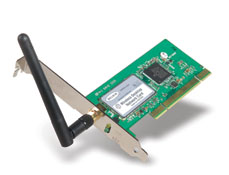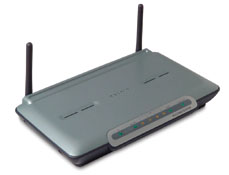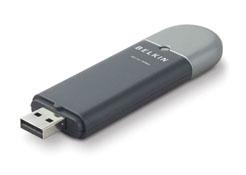 |
|
|||||||
|
How To
Going Wireless I recently decided to go wireless when my wife set up her new PC several rooms away from where my internet modem was located and wanted to use our DSL service. After checking out a hard-wired router that would allow us to share the connection, it became apparent that running a cable from the router to her computer would be a major undertaking. And since I also wanted to use my Mac laptop outside when the weather was nice and be able check my email from time to time, wireless seemed like the perfect solution.
The router takes your internet signal öafter it passes through your modemö and directs it to multiple computers, wherever they may be. You simply remove the cable that connects your modem to your computer and plug it into the router insteadö itās a no brainer. You then have to configure the router; that can be a little dicey but, as it turned out, the whole network was a lot easier to set up than I thought. Hereās the best (and simplest) way to do it. 1. Buy a router with good manufacturer tech support. There are many possible settings (depending on how your cable or DSL modem is configured) and even a well-written manual can be hard to decipher. I chose Belkin equipment because it comes with toll-free, 24/7 phone support. When I ran into a problem on the Sunday afternoon I chose to do my installation, I called them. Sure enough, someone on the other end was immediately available to cheerfully walk me through it, step by step, and in less than ten minutes I was up and running. 2. The router I chose, the 802.11g Wireless DSL/Cable Gateway Router (MSRP US$80) has both wired and wireless capabilities so I could easily run the existing cable from my nearby desktop computer to it while using its wireless capabilities for my wifeās distant computer and our laptops.. 3. This particular router can serve as many as four computers at a time. But each computer you want to use has to be capable of receiving its signal. You can accomplish that in several ways. 4. I popped a Belkin 802.11g Wireless Desktop Network Card (MSRP US$20) into my wifeās PC, a ten-minute job, including installing the software drivers. As soon as the computer rebooted, it immediately recognized the signal that was being sent from the router and she had Internet access. 5. If you donāt want to dig around in the guts of your machine to install a wireless card, you can get a Belkin Wireless G USB Network Adapter (MSRP US$67). Plug it into any USB port on your desktop computer or laptop, install the drivers, and youāll be in business.. 6. My wife also has a PC laptop with built in wireless capability. When she booted it up, it automatically received the wireless routerās signal and she was able to use it anywhere inside or outside the house. 7. Not to be outdone, I then fired up my Mac iBook which has an older 802.11b wireless Airport card installed and it recognized the Belkin router, too. I took it outside and received a super-strong signal from the router at 70 feet away, which is smack in the middle of my garden.
Which 802 should I get? No, it didnāt start with 802.11a, and 802.11b isnāt better than 802.11a. 802.11b just so happened to be the WiFi standard that caught on. These days, 802.11b equipment is dirt cheap because it is slower than some of the newer and faster standards. 802.11a is much faster, but it isnāt compatible with 802.11b equipment. 802.11a has one big advantage: It uses the 5-GHz spectrum where there is none of the interference from cordless phones and other household gizmos that occasionally bedevils 802.11b connections. 802.11g is faster and uses the same 2.4 GHz frequency as 802.11b. It suffers from interference like 802.11b, but its compatibility with existing equipment means that the 802.11g standard is winning. There are some (rather expensive) products that offer all three standards, and thus the best of all worlds. Such products can be configured so that they switch to the interference-free 802.11a protocol for certain operations where speed matters, such as transferring large files between certain devices, while using 802.11b or g for less demanding chores. Our advice: go with 802.11g. It is fast and inexpensive. -Arthur H. Bleich (arthur@dpcorner.com) is a photographer, writer, and educator who lives in Miami. He does assignments for major publications both in the U.S. and abroad, and conducts digital photography workshop cruises. Visit his Digital PhotoCorner at www.dpcorner.com.
|
|||||||
|
|
|||||||
|
©
2004 D.C. Publications, Inc. All Rights Reserved. |
|||||||


 If
you want to share a cable or DSL connection between two or more
computers at different locations inside your home, wireless can
make it virtually effortless. And then, of course, thereās the convenience
of taking your laptop anywhere within wireless range without losing
Internet access. Since the web is such an integral part of our lives
these days, thereās a great need (some might describe it as a compulsion)
to stay connected wherever we are.
If
you want to share a cable or DSL connection between two or more
computers at different locations inside your home, wireless can
make it virtually effortless. And then, of course, thereās the convenience
of taking your laptop anywhere within wireless range without losing
Internet access. Since the web is such an integral part of our lives
these days, thereās a great need (some might describe it as a compulsion)
to stay connected wherever we are.  Wireless
routers today usually use one of two standards, both of which are
compatible. The granddaddy is is 802.11b while the other is the
newer and more powerful 802.11g with faster data transfer (54Mbps
vs. 11Mbps) and longer range (up to 1,800 feet under optimal conditions).
Wireless
routers today usually use one of two standards, both of which are
compatible. The granddaddy is is 802.11b while the other is the
newer and more powerful 802.11g with faster data transfer (54Mbps
vs. 11Mbps) and longer range (up to 1,800 feet under optimal conditions).
 Once
your wireless network is set up, your computers can share files,
printers, and scanners, and your laptop will be able to connect
wirelessly to the Internet at various hotspots in hotels, airports,
coffee houses, and other locations. (Check out: www.wi-fihotspotslist.com).
Itās great way to go!
Once
your wireless network is set up, your computers can share files,
printers, and scanners, and your laptop will be able to connect
wirelessly to the Internet at various hotspots in hotels, airports,
coffee houses, and other locations. (Check out: www.wi-fihotspotslist.com).
Itās great way to go!